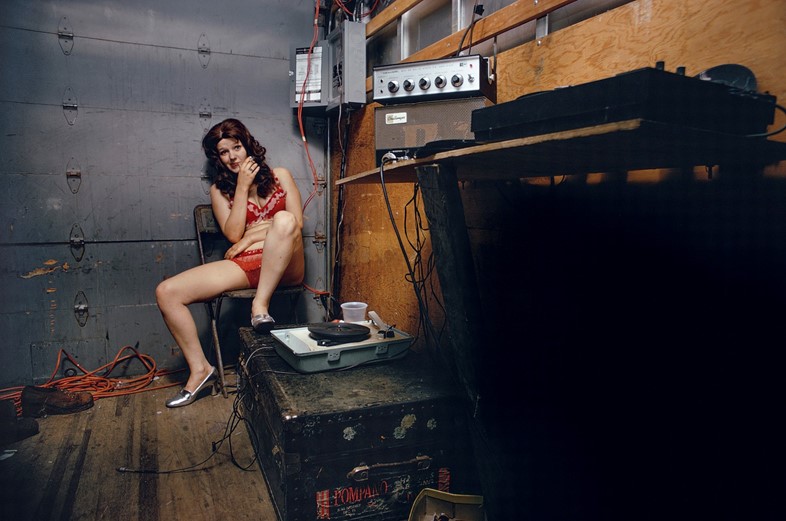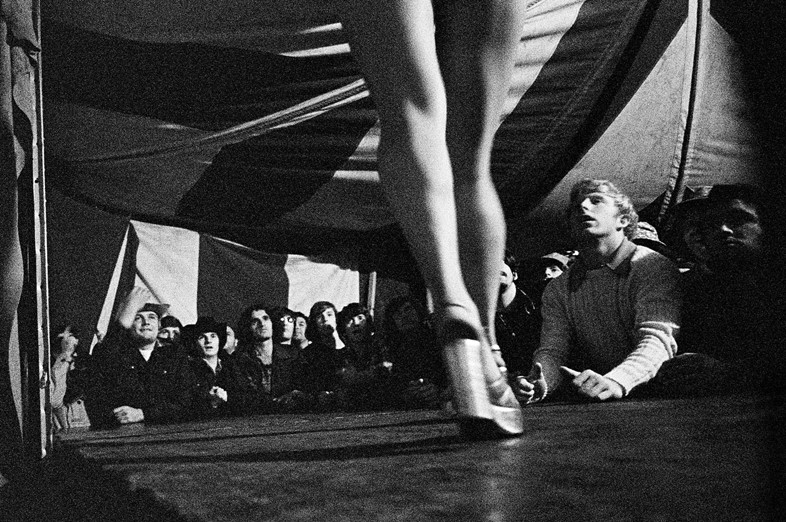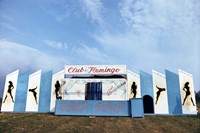In the early 1970s, Susan Meiselas photographed “carnival strippers” as they travelled across New England navigating the taboo world of male desire – now, the empathetic book gets a reissue
In the summers of 1972 until 1975, Susan Meiselas travelled across New England, photographing “carnival strippers”: girls and women between the ages of 17 to 35 who worked out of a “travelling box” – a truck that opened onto the public or private areas of rural state fairs. Beyond the agricultural facade of the carnivals, these women – and their bodies – were the main attraction.
The all-male audience typically included farmers, bankers, fathers, and sons, but strictly “no ladies and no babies”, Meiselas tells AnOther. But it was this exclusion that propelled her to photograph the women with her 35mm Leica camera, leading to the book Carnival Strippers (1976). With an ethnographic approach including transcribed audio segments and interviews, Meiselas chronicled the nightly routines of these women as they navigated a licentious and taboo world of male desire. By observing the sexualisation of other women, Meiselas created one of the first photographic series to distill the dynamics of the male gaze – before feminists had coined the concept.
Born in 1948, Meiselas studied at Sarah Lawrence College followed by a Master’s in visual education at Harvard University. In the early 1970s she taught photography at public schools in the South Bronx. Shortly before her 24th birthday, Meiselas and her then-partner, the photographer and filmmaker Richard P Rogers, took a road trip along the East Coast. That’s when she first encountered the carnival strippers – in the back areas of a state fair in Bangor, Maine. “I didn’t have a clue that these girl shows existed … it opened up questions that I wanted some answers to,” she says.
These young women – who were offering their bodies as a form of entertainment – presented a rich subject matter, one that was rife with unresolved issues relating to the Women’s Liberation Movement, but also sexuality, class, labour and the ethics of voyeurism and photography itself. “How were these women being perceived, and how they perceived themselves – that’s what I wanted to understand better. I wanted to hear directly from them.”
Researching from the pages of Variety magazine, Meiselas followed the route of the itinerant shows. She became acquainted with the managers and gained the trust of the women, developing friendships with figures such as Lena (who appears on the book cover), Ginger and Shortie. “The women weren’t obliged to let me into their dressing room, but they invited me in. It was an intimate space and I would be there for hours and hours with them, from the evening until the show wrapped up. Night after night, town after town.”

In the original Carnival Strippers, excerpts of dialogue form a parallel narrative alongside the images, appearing throughout the book. But in the revised edition, and in the accompanying publication, Making Of, some of the longer interviews feature prominently alongside the original contact sheets. By including her own notebook and the women’s voices, as well as alternative images, Meiselas gives readers “a sense of the book’s multiple layers. She shares how much processing and selecting was involved, and reveals the depth and complexity behind the project.”
Meiselas’ candid yet multifaceted view of sex work contemplated the socio-economic conditions surrounding the industry, while providing the women with agency. Her subjects came from working-class backgrounds, or precarious circumstances that denied them of a sense of personal liberation, or the opportunity for good pay or the chance to leave their hometowns. “There was a strong expression of self-determination. What many of them were trying to express was ‘this is my life and I should have the freedom to live this way’. It was a way of finding empowerment – before this word became regularly used.”
Sisterhood and solidarity coalesce as themes in Carnival Strippers. Yet a “competitive and collaborative spirit” also characterised dynamics between the women. At some state fairs, three to four-girl shows operated simultaneously, meaning they were pitted against one another. “You could sense they were looking at each other’s bodies as they were competing for men’s attention. But simultaneously they were bonding because they were in it together.” Meiselas explains. An underlying, shared fear of violence perhaps diminished female rivalry too.

Meiselas’ series penetrates both the male and female gaze from all angles, through visual and textual storytelling: interviews with the performers, their families, managers, male customers, as well as their wives and girlfriends who could see the carnival strippers from the public grounds. Aware of the negative perceptions surrounding stripping and sex work, especially within the feminist movement, Meiselas deliberately offered a non-judgemental counterview: “I think the women trusted me because I was listening to them. I knew what the feminist debates were surrounding them. But I wanted to discover how they perceived themselves – beyond those discussions.”
Meiselas joined Magnum Photos in 1976, the same year Carnival Strippers was published. Since then she has travelled the world with her camera, immersing herself in human stories against the backdrop of violent events, notably the insurrection in Nicaragua and the plight of refugees in Kurdistan. Committed to inclusivity, she continues to use photography to lay bare the subjectivities of individual subjects and the systems surrounding them – a signature approach that distinguished Carnival Strippers.
On her desired reactions to the project, she says: “I can only hope that any reader might engage and listen to the voices of those who were most involved … to place themselves within all of those perspectives, with power dynamics that continue to resonate, and many of which we continue to wrestle with today.”
Carnival Strippers Revisited and Making Of by Susan Meiselas are published by Steidl. Susan Meiselas: Carnival Strippers Revisited will be at Magnum Photos in Paris until 30 April 2022 and Susan Meiselas: Carnival Strippers Color, 1972-1975 will be at Higher Picture Generation in New York until 16 April 2022.






